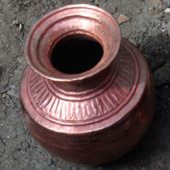Design Resource
Tamta Copperware - Almora
Copper Craft Clusters
by
Prof. Bibhudutta Baral, Aruna Kumari Y., Shruti K., Shivangi Sharma and B. Srikanth
Cutting:
Copper is soft metal when compared other metals like brass, bronze, iron. Hence it is easily malleable into required shape. The copper sheet is beaten to make it flat. The design outlines are marked on the product as per the shape of the product to be made. The copper sheet is then cut with scissors. Now, properly cut copper pieces are sent for annealing and shaping process.
Heating and Shaping:
Heating process is also called annealing which is done to strengthen the copper sheet. The sheet is heated on a furnace and then shaped by beating with wooden mallet. The process of heating and beating is repeated until the required shape is obtained. The heat treatment facilitates to strengthen and harden the material. After heating and shaping, the partially shaped copper pieces are allowed to cool at room temperature.
Designing:
The motifs designs are engraved on the surface by chiseling and beating processes. Chiseling is done to engrave geometrical and floral patterns. Where in beating on the objects help to obtain dotted patterns. Basically, the bigger products like pot and water filter are done in two parts. The upper part is embellished with line and geometrical designs as it is lighter, but the lower part of the pot is made with thick copper sheet, hence it is beaten to create dot patterns and also to strengthen the base.
Soldering:
The parts of the product are made separately and then joined together. These joined parts are soldered. For joining, a powder (made of suhaaga, jasta, petal, kansa, raang and nausadar) is mixed with water and applied on the joined areas. The product is again heated on furnace then allowed to dry.
Polishing:
Polishing is the final process done to obtain shine and luster to the product. After soldering process, the product is washed with diluted acid solution. Finally it is washed with tamarind solution to obtain more lustrous look.


























